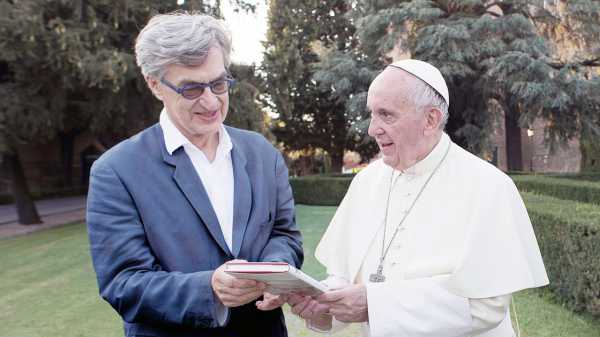
Before it was the name of a band, “talking heads” was a term in television production: a derogatory term for the low-tech, unimaginative visual approach taken by news broadcasts and talk shows, which would film an ordinary-looking, middle-aged man speaking as he looked straight into the camera.
Wim Wenders is the last person you would associate with the talking-heads approach. The name of the German-born auteur brings to mind sweeping images from his celebrated films of the eighties—the vast and uninhabited flatlands of “Paris, Texas,” complemented by Ry Cooder’s acoustic slide guitar; the angels lurking over Berlin in “Wings of Desire,” the divided city shown spectacularly from on high in art-house black-and-white. The approach Wenders takes in his new film, about Pope Francis, then, is surprising and refreshing, and a good fit for a Pope who urges simplicity.
In 2013, Wenders was invited to make a film about Pope Francis by Monsignor Dario Viganò, who was the head of the Pontifical Council for Social Communications, and who had followed Wenders’s work ever since the director spoke to a film club in Rome where Viganò was a member, many years earlier. Wenders, raised a Catholic in postwar Dusseldorf, had followed Pope Francis’s doings from the day of his election, in March, 2013. After he signed on to the project, Wenders was given uncommon access to Pope Francis, and to the Vatican’s footage of Francis’s pontificate. Wenders was assured substantial independence, with the Vatican exercising no formal approval over the final cut or over his approach in general.
The title, “Pope Francis: A Man of His Word,” suggests the nature of the work. The film will present Francis as a person of uncommon integrity, who has walked the walk of Christian faith all the way to St. Peter’s Basilica, and it will convey that integrity through his words—long filmed stretches of the man talking, in Italian and Spanish, giving his words emphasis with his eyes and his smile.
The film’s opening minutes move the viewer away from expectations—what we might expect from the director, and what we might expect from the first commercial film made with the cooperation of a sitting Pope. There’s a shot of the heavens; a descending shot of an Italian village, which turns out to be Assisi; a black-and-white scenario involving the village’s most famous inhabitant, St. Francis. And then there is the scene of a crowded plaza in Argentina in 1989, and a clergyman in a black suit and clerical collar speaking passionately: thinner and more severe-looking than the man we now know, but recognizably Jorge Mario Bergoglio—Pope Francis.
In his five years as Pope, Bergoglio has made certain ideas the basis for his work. The best known is mercy: the church, he said, in a definitive September, 2013, interview with the Jesuit priest Antonio Spadaro, should be like “a field hospital after battle,” a place to care for others without making distinctions based on faith or lack of faith. “It is useless to ask a seriously injured person if he has high cholesterol, or about the level of his blood sugars. You have to heal his wounds. Then we can talk about everything else.” In the same moment, he set out another crucial idea. The church, he said, “needs to warm the hearts of the faithful . . . it needs nearness, proximity.” The Church, especially the clergy, should be among the people—most importantly the poor—seeing their lives and challenges near at hand. Friends and family should be in proximity to each other, through time spent together: meals, conversations, affection, tenderness. All this is framed by the conviction that the central Christian mystery—God becoming man, the father sending his son—is about the divine effort to draw nearer to humanity, and vice versa.
For the film, Wenders found an aesthetic of nearness. We are brought near to Francis and, through Francis, to the people and issues that he is convinced should concern us most. In Vatican footage, we are over his shoulder in a helicopter above Naples, over his shoulder as the Popemobile conveys him through an open field in Bolivia, at his side in a children’s hospital in the Central African Republic. We are near at hand for the now canonical moments of his pontificate, moments most of us have read about but have not seen: as he washes (and then kisses) the feet of a man in jail on Holy Thursday; as he explains to reporters, on the papal plane, that “if someone is gay, and he searches for the Lord and he has good will, who am I to judge?”; and as he tells the clerical bureaucrats of the Roman Curia, assembled in the Sistine Chapel, that they are prone to “careerism and opportunism,” “the hypocrisy typical of the mediocre,” and “spiritual Alzheimer’s.”
This footage is juxtaposed with images that bring us closer to the core issues of poverty, pollution, and forced migration. In a spectacular sequence (again, made from Vatican footage), the image of a giant heap of discarded cell phones is projected, as onto a giant screen, onto the façade of. St. Peter’s Basilica at night. More often, images of global catastrophe—say, people sifting through trash at a vast garbage heap—are set against images of Francis talking about the issues. The effect is akin to that of the film adaptation of Al Gore’s book “An Inconvenient Truth”—employing a person of integrity to make daunting, abstract problems seem real, urgent, and possible to solve.
Folded into all these are sequences of Francis speaking to the camera unguardedly and at length. These are the fruits of Wenders’s arrangement with the Vatican, but they aren’t made into displays of inside access or bent-knee gratitude. They are of a piece with the elderly Cuban musicians recounting their lives in Wenders’s hit documentary “Buena Vista Social Club,” from 1999. The Pope speaks, and the big deal is that it is no big deal.
In New York, last week, following the film’s première at Cannes, Wenders readily agreed to the idea that the film is all about nearness. “Pope Francis calls St. Francis of Assisi ‘the apostle of the ear.’ When you lend someone your ear, you are drawing close to that person—drawing near. Pope Francis has an uncanny ability to create that nearness. I was given an incredible chance to be near to him: four sessions, two hours each, face to face, eye to eye. I knew I couldn’t have this experience just for myself. So I tried to find a way to share the experience. That was the whole task: to create nearness, to translate it to the audience.”
Wenders is seventy-two, with a head of thick, gray hair, blue-frame spectacles, near-perfect English, and a lover’s passion for New York City, where he first spent time in the early nineteen-seventies—at the Warwick Hotel, on West Fifty-fourth Street, around the corner from the Dolby screening room where “A Man of His Word” was showing.
“I was committed to this film being cinema povera,” he said, using the Italian term for the cinematic variant of the postwar Arte Povera movement, which pioneered art made simply and on limited budgets. “I had declared early on that it would be a film with no means, because how can you spend a lot of money on a film about this Pope when this Pope is telling us to live more simply?” This commitment led him to simplify the sessions with Pope Francis; to screen “hundreds of hours” of footage from the Vatican archive, rather than undertaking fresh location shoots; and to record the scenes involving St. Francis of Assisi with a century-old “hand-crank camera,” at once limiting costs and plunging the viewer into the past through past technology.
After many years away from Catholicism, Wenders became a churchgoer again, this time as a Protestant; the work of the Catholic Richard Rohr, a Franciscan spiritual writer based in New Mexico, has had a powerful effect on him. In 1990, with “Wings of Desire” standing as a strong expression of cinema’s spiritual yearnings, he declared that “a film has to be preceded by a dream, either a real dream of the sort that you wake up and remember, or a daydream.” What, then, was the dream that preceded this film, which was made at the Vatican’s invitation? He hadn’t been asked that question before, he said, but he answered without a pause. “The dream is of a little boy who grew up Catholic, but not knowing any of the saints, except one—St. Francis of Assisi. This saint spoke to birds; he called the sun and moon ‘sister’ and ‘brother.’ I loved him more than anything. He was a true hero of mine.”
Sourse: newyorker.com






